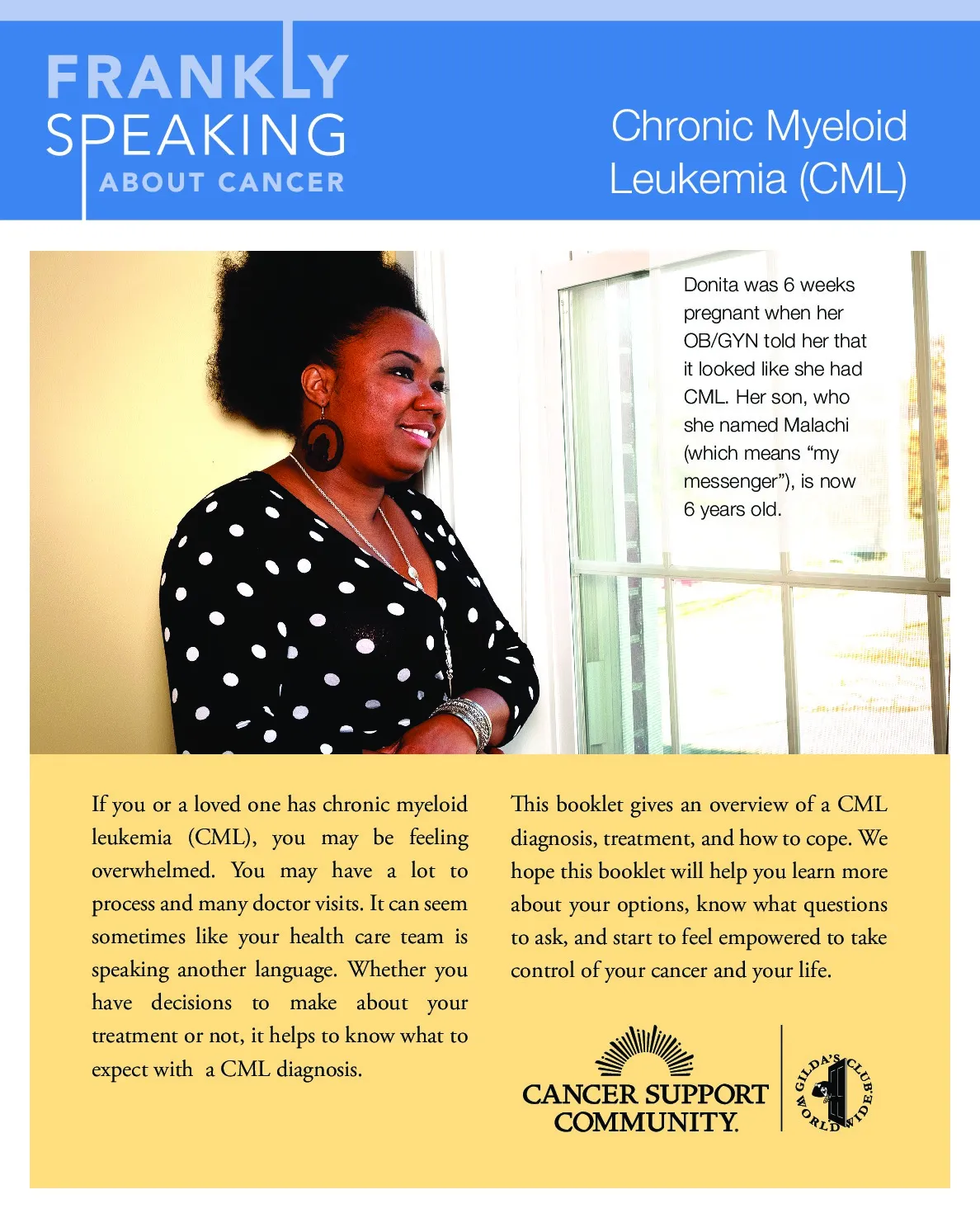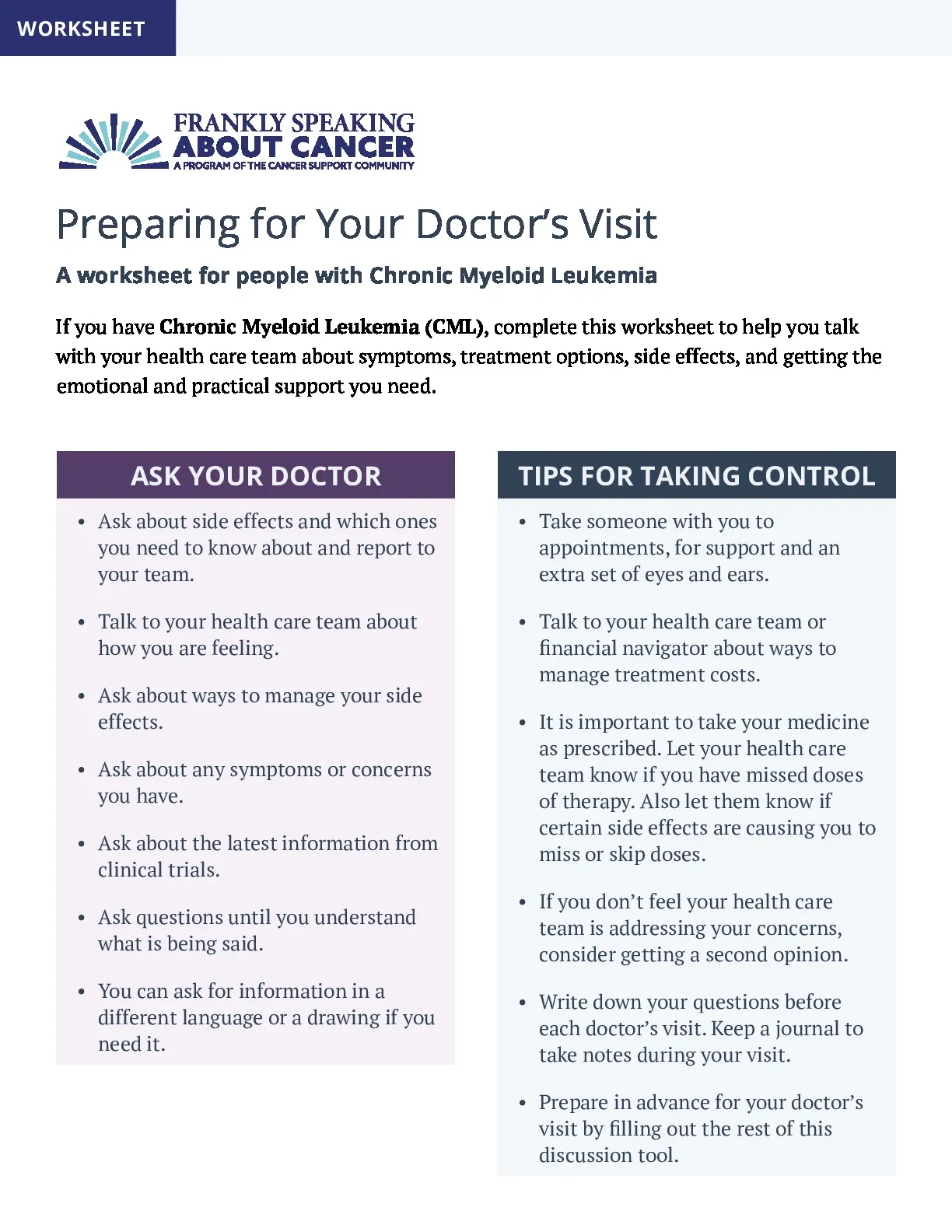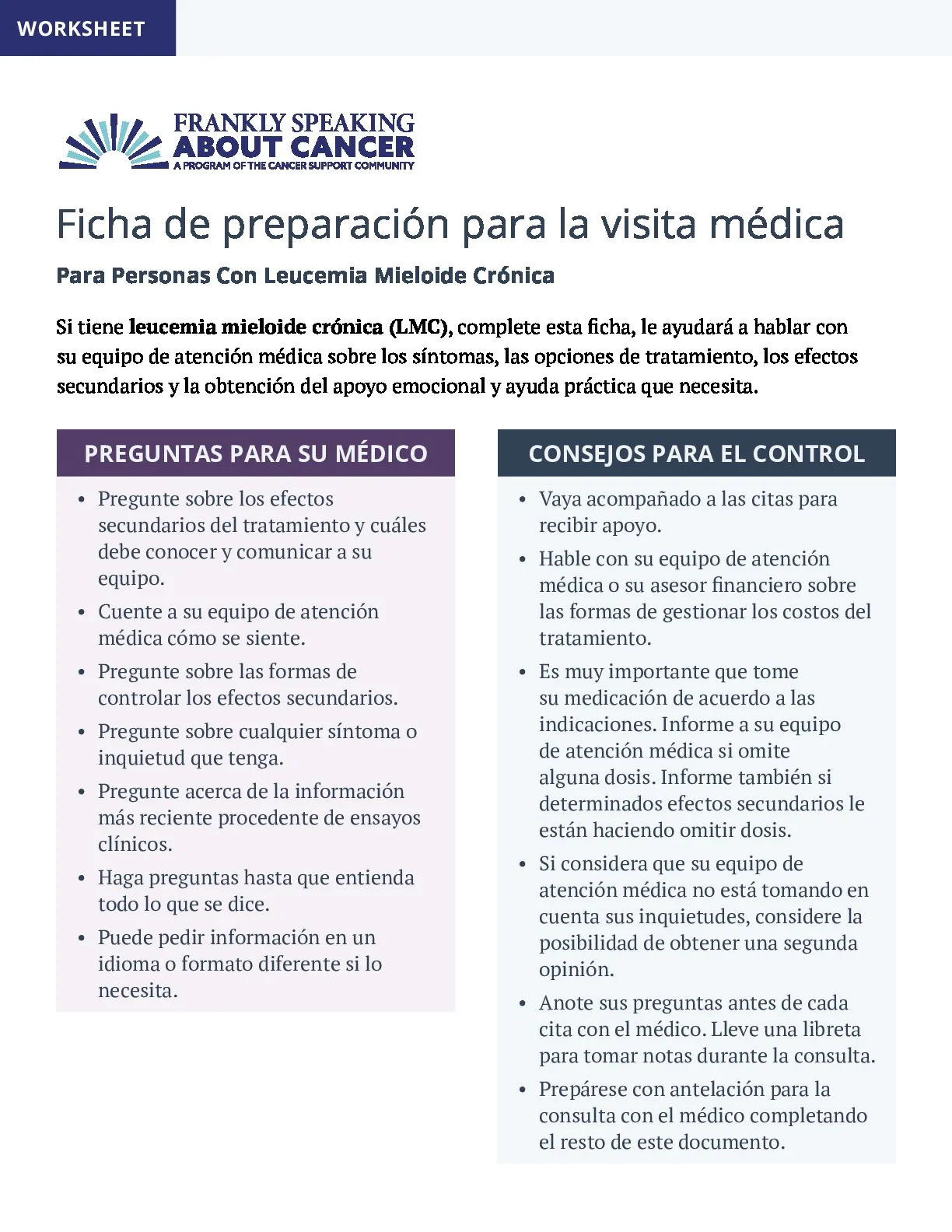Chronic Myeloid Leukemia
Table of Contents
Chronic myeloid leukemia (CML) is a blood cancer. It begins in myeloid cells which are made in the spongy center of bones (bone marrow).
Healthy myeloid cells form a balance of different blood cells: red cells, some types of white cells, and platelets. In CML, genetic changes cause myeloid cells to produce blood cells that grow out of control.
This leads to an increase in white blood cells, abnormal numbers of platelets, and low numbers of red blood cells. When red blood cells are choked-out, then they can’t carry enough oxygen through the body.
Gene mutations often seen in CML include the fused gene called BCR-ABL and the abnormal Philadelphia chromosome:

Talking About CML
You will hear many words used to describe CML.
Some key ones to know are:
The abnormal gene that leads to CML. It is formed when pieces of chromosomes 9 and 22 break off and trade places.
(FIH-luh-DEL-fee-uh KROH-muh-some) A genetic change on chromosome 22 where part of chromosome 9 attaches to it. A fused gene ( BCR-ABL) is part of Ph. This is seen in most CML cases. It is named for the place it was found.
Immature white blood cells that grow out of control. These are found in leukemia. Normally they are not found in the blood.
Tyrosine kinase inhibitors are a type of targeted therapy. They block a specific process in cells to stop cancer cells from growing.
Who gets CML?
A small percent of all leukemia cases are CML. Radiation exposure may lead to CML. Most people are diagnosed as adults, over age 60. Generally, risks increase with age.

Diagnosis & Phases
Signs & Symptoms
CML symptoms start as vague problems. If there are symptoms, they can include:
- Feeling tired or weak
- Losing weight
- Fevers
- Sweating (especially at night)
- Pain or fullness in the left side of the belly when the spleen, an organ that filters blood and fights infection, gets bigger, and can cause symptoms
Many people are surprised to be diagnosed with this blood cancer.
Diagnosis
Several tests are used to diagnose and track CML.
Physical exam: Includes talking about your symptoms and feeling if your spleen is enlarged or swollen (a sign of an abnormal blood condition).
Lab tests: Done to diagnose CML at first, then to track how well treatment works.
Blood tests: Check the complete blood count (also called “CBC”) and the types of white blood cells in a blood sample.
Bone marrow tests: Removes samples of bone marrow and blood from the pelvic (hip) or breastbone. The sample is looked at closely to observe the blood cells. The number of immature white blood cells (blasts) is used to tell the phase of CML.
Molecular testing: Looks at the bone marrow and blood to look for changes in the cancer cell’s genes (DNA). Three types:
- Cytogenetics (also called karytyping) – looks at whole chromosomes (pieces of DNA) to check their number and structure
- Fluorescence in situ hybridization (FISH) –looks at the chromosomes with the use of a dye that tags certain parts
- Quantitative polymerase chain reaction (qPCR) – measures the amount of BCR-ABL gene
Phases of CML
Tests that diagnose CML also show the phase of the disease. The phase describes how much CML has grown and if it is aggressive. Different phases require different treatment.
The 3 phases of CML are:
- Chronic Phase — most patients are diagnosed during the chronic phase. CML in this phase often responds well to treatment.
- Accelerated Phase —means that the number of blasts increase, the spleen is large, and blood counts are out of balance. For example, platelets may drop low. This phase is harder to treat. There are more mutations in the genes of the leukemia cells.
- Blast or Blast Crisis Phase —means that the number of blasts increases to the point where it looks and behaves like acute myeloid leukemia or acute lymphoid leukemia. CML in the blast phase is difficult to treat. Treatment may bring it back to the chronic phase or into remission.
Without treatment, the chronic phase of CML can progress to the accelerated or blast phases within a few years. With TKI treatment the progress to these higher phases is greatly reduced.
Treatment
Because CML is a chronic condition, most people need treatment for a long time. It helps to learn as much as you can about treatment before you begin.
At all times during treatment, be sure to tell your health care team how you feel. There are many ways to manage symptoms and side effects to reduce problems.
Targeted Therapy/ TKIs
CML and TKI treatment can cause low counts for white blood cells, red blood cells, and platelets. This can put you at increased risk for infection, anemia, and/or bleeding. Before beginning treatment, you should alert your healthcare team if you have a history of inflammation of your pancreas (pancreatitis). A common side effect of TKIs are changes to your pancreas. Other common side effects include nausea and vomiting, diarrhea, muscle cramps or muscle/joint pains, puffy eyes, headache, blood pressure changes fatigue/weakness, and skin rash. These are often short-lived and can be managed by briefly stopping or lowering the dose of a TKI.
If you are taking TKIs, your doctor should monitor your heart health and your risk of heart disease. TKIs may increase the risk of heart disease or related problems in the circulatory system. There are heart specialists called cardio-oncologists who can care for you.
Stem Cell Treatment
A stem cell transplant uses powerful doses of chemotherapy to destroy cancerous blood cells. This begins by either removing healthy stem cells from your blood or by using donor stem cells. After high-dose treatment, healthy stem cells are put back into your body to grow healthy blood cells. For basically healthy patients, stem cell transplants can lead to remission.
Learn More About a Stem Cell Transplant and Side Effects
Chemotherapy
Chemotherapy are very strong drugs that can kill many cells at one time. When healthy cells die in the process, it leads to side effects.
Hydroxyurea (Droxia, Hydrea) – used to lower the number of white blood cells before oral TKI therapy or to help if TKIs are not working. It may be used in any phase of CML. This drug is given as a pill.
Omacetaxine mepesuccinate (Synribo®) – used when TKIs haven’t worked. It is also used for some patients whose CML has the T315l mutation. This drug is given as an injection.
Common side effects from chemotherapy are:
- Anemia: tiredness (fatigue), dizziness, weakness, headaches, pale coloring
- Low blood counts: Causing easy bruising, unexplained bleeding, higher risks of infection
- Alopecia: hair loss (all body hair can be affected)
- Mouth and throat sores, dry mouth or changes in taste, loss of appetite, nausea and vomiting
- Diarrhea or constipation
- Peripheral neuropathy: numbness, tingling, burning sensations in hands or feet
- Damage to the reproductive system (if you plan to have children, talk about this with your health care team before starting chemotherapy treatment.)
Low-dose chemotherapies and consolidation therapy cause fewer side effects.
Immunotherapy
Before TKIs, immunotherapy was the main treatment for CML patients who couldn’t have a stem cell transplant. Interferon (Pegasys®, PegIntron®, Intron®A, Roferon®-A) is the main type used. It is given as an injection. It may help patients who can’t use TKI therapy, or patients who are pregnant.
Side effects may include swelling, bloating, sudden weight gain, anemia, nausea/vomiting, diarrhea, muscle cramps or rashes. These side effects often go away after treatment is done.
Discover More About Coping With Immunotheapy Side Effects
Clinical Trials
Clinical trials are research studies to test new treatments or learn how to use current treatments better. A clinical trial may be the only way to get certain treatments for CML, including some that are very promising. A doctor experienced in treating CML should be able to recommend specific trials.
It’s important to ask about possible side effects before you begin, so you know what to expect and how to manage problems.
Key things to know
- Clinical trials for CML are done to test new drugs, combinations of drugs, or different stem cell transplants.
- The U.S. FDA and local review boards oversee all U.S. clinical trials to keep patients safe.
- If you join a clinical trial, you can leave at any time.
- Be sure to ask about costs. A trial may pay the costs of the drug being studied.
Learn More About Clinical Trials
Monitoring CML Treatment
Many of the same tests used to diagnose CML are used to see how treatment is working.
- A complete blood count (CBC) with differential – to look for a Complete Hematologic Response (CHR).
- Cytogenetics and FISH – to look for a Complete Cytogenetic Response (CCyR)
- Polymerase Chain Reaction (PCR) – This test tells your doctors how much leukemia is in your body, so how deep your remission is. Your doctors look for an Early Molecular Response (EMR) of 1/10th the number you started with. A Major Molecular Response (MMR) is a level 1,000 times smaller than you started with. An even larger response is called Deep Molecular Remission (DMR). After being in DMR for some time, your doctors may offer to take you off of treatment for observation.
Coping With CML
With CML, you may look and feel good with treatment, but you will likely need to manage treatment for the rest of your life. Managing any chronic condition takes work, and you may need help.
Tips for coping with CML:
- Take care of your body. Focus on nutrition and exercise based on the guidelines that your health care team gives you. If you smoke, try to stop.
- Increase energy levels by staying active throughout the day. Maintain a routine sleep schedule.
- If you feel sad or depressed, seek medical help and/or let your care team know.
- Once your treatment is stable, you might only see your doctor a few times per year. If you change anything (stop, or start something new) let someone on your health care team know. Even small changes can affect how well the drugs work.
- Connect with others who share your struggle and can help you find support. Other people who’ve “been there” can understand the specific challenges you may have. Local resources, like those at CSC’s and Gilda’s Clubs, may have a blood cancer support group. Or, you can ask your health care team how to connect with others who also have CML.
- If the nearest leukemia center is far away, or if you decide to join a clinical trial, you will have to consider travel arrangements.
- If you can’t find a local resource for personal CML support, consider trusted information online. Seek webpages and chat rooms offered by blood-cancer specific patient groups.
- Ask the hospital’s social worker or your health care team how to get in-home support if you need it.
- Consider asking friends and family to help with household tasks, cooking, cleaning, errands, rides, childcare, financial support, etc. An online planner, such as MyLifeLine.org, may help.
Cost and Expenses
The treatment for CML and follow-up appointments can be costly. Many families worry about the costs of cancer care, and they don't know where to turn. If you have health insurance, it’s important to learn about your policy. Consider talking with a financial counselor, reviewing our online information, or call our Cancer Support Helpline 888-793-9355.
Tips From Patients Living With CML
Tips for the Newly Diagnosed CML Patient
Diane, a Chronic Myeloid Leukemia (CML) survivor, shares helpful tips for the newly diagnosed.
Donita's CML Story
Donita, a Chronic Myeloid Leukemia (CML) survivor, shares her experience with CML, including what it was like to be diagnosed while pregnant.
Diane's CML Story
Chronic Myeloid Leukemia (CML) patient, Diane, shares her story.
Living with Chronic Myeloid Leukemia
Donita, a Chronic Myeloid Leukemia (CML) survivor, discusses the importance of honesty when living with CML.
Living with a Chronic Cancer
Chronic Myeloid Leukemia (CML) patient, Diane, shares helpful tips for living with a chronic cancer.
Coping with Side Effects
Chronic Myeloid Leukemia (CML) patient, Diane, shares helpful tips for coping with side effects.
Coping with Fatigue
Chronic Myeloid Leukemia (CML) patient, Diane, shares helpful tips for coping with fatigue.
Getting Support From Your Health Care Team and Family
Donita, a Chronic Myeloid Leukemia (CML) survivor, discusses the valuable influence of support from her healthcare team and family.
Tips for Communicating with your Health Care Team
Diane, a Chronic Myeloid Leukemia (CML) survivor, shares helpful tips for communicating with your health care team.
Living with Cancer When It Is Not Obvious
Chronic Myeloid Leukemia (CML) patient, Diane, shares helpful tips for living with cancer when it’s not obvious.
Tips for Family and Caregivers
Chronic Myeloid Leukemia (CML) patient, Diane, shares helpful tips for family and caregivers.
Finding a Medication That Works for You
Chronic Myeloid Leukemia (CML) patient, Diane, shares helpful tips for finding a medication that works for you.
Tips on Finding Support
Chronic Myeloid Leukemia (CML) patient, Diane, shares helpful tips on finding support.
Support Groups for Pregnant Women with Cancer
Donita, a Chronic Myeloid Leukemia (CML) survivor, shares the positive impact of finding support groups for pregnant women with cancer.
Learning About Blood Work
Chronic Myeloid Leukemia (CML) patient, Diane, shares helpful tips for learning about blood work.
Tips for Coping with Cancer
Chronic Myeloid Leukemia (CML) patient, Diane, shares helpful tips for coping with cancer.
Coping with the Cost of Treatment
Chronic Myeloid Leukemia (CML) patient, Diane, shares helpful tips for coping with the cost of treatment.
Dealing with the Cost of Oral Drugs
Donita, a Chronic Myeloid Leukemia (CML) survivor, discusses the difficulties of dealing with the cost of oral drugs, especially when undergoing changes in health insurance coverage.
Finding Co-Pay Assistance
Chronic Myeloid Leukemia (CML) patient, Diane, shares helpful tips for finding co-pay assistance.
Frankly Speaking About Cancer Library
LibraryWould you like a print copy of these educational materials?
We can mail our Frankly Speaking About Cancer pieces to you. Shipping is free for up to 20 pounds.
Your Experience Matters
Help improve outcomes for CML patients & caregivers. Join the Cancer Experience Registry.






















